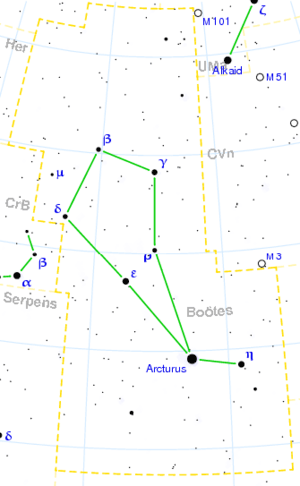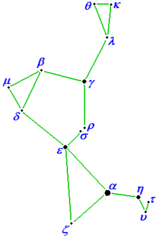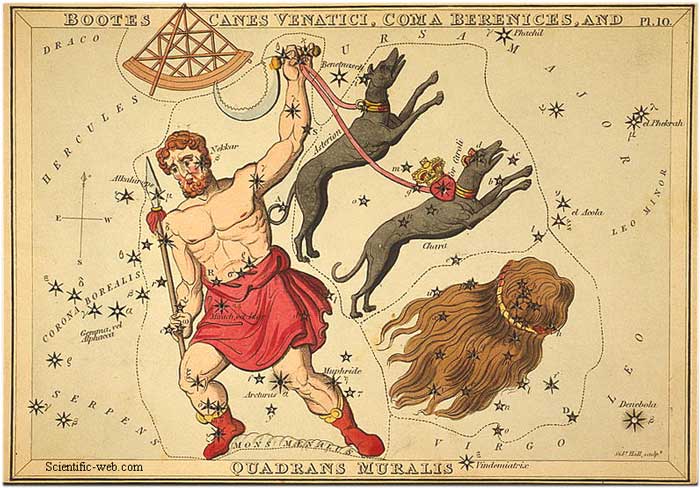
|
Boötes ( Greek: Βοώτης or herdsman) is one of the 88 modern constellations and was also one of the 48 constellations listed by Ptolemy. Boötes is generally referred to as the Bear Watcher, since it appears to be watching over the constellations Ursa Major and Ursa Minor. It contains the third brightest star in the night sky, Arcturus. Note that the "ö" in the name is a diaeresis, not an umlaut. The constellation is located between 0° and +60° declination, 13 and 16 hours of right ascension on the celestial sphere. Notable features τ Boötis, a relatively Sun-like star, has the massive hot Jupiter τ Boötis Ab. It is the fourth extrasolar planet discovered and is one of the most studied. Boötes also hosts a large number of double stars suitable for viewing by amateur astronomers. NGC 5466 is a loose globular cluster that can be observed with most telescopes. It was discovered by William Herschel on May 17, 1784. The Boötes void, a large section of the universe devoid of galaxies, is located in the area of Boötes. Mythology Including the fainter stars, Boötes appears to be a large human figure, looking toward Ursa Major [1]. Exactly whom Boötes is supposed to represent is not clear. According to one version, he was a ploughman who drove the oxen in the constellation Ursa Major using his two dogs Chara and Asterion (from the constellation Canes Venatici). The oxen were tied to the polar axis and so the action of Boötes kept the heavens in constant rotation. Boötes was also supposed to have invented the plough. This is said to have greatly pleased Ceres, the goddess of agriculture who asked Jupiter to give Boötes a permanent fixture in the heavens as a reward for doing this. Another version portrays Boötes as a grape grower called Icarius, who one day invited the Roman god Bacchus, also called Dionysus, to inspect his vineyards. Bacchus revealed the secret of wine making to Icarius, who was so impressed by this alcoholic beverage that he invited his friends round to sample it. Having never tasted wine before, they all drank too much and woke up the next morning with terrible hangovers; and they made the mistaken assumption that Icarius had tried to poison them. It was decided that Icarius should pay the price with his own life, and he was swiftly murdered in his sleep. Bacchus placed Icarius in the stars to honor him. Following another reading the constellation is identified with Arcas, son of Zeus and Callisto. Arcas was brought up by his maternal grandfather Lycaon, to whom one day Zeus went and had a meal. To verify that the guest was really the king of the gods, Lycaon killed his grandson and prepared a meal made from his flesh. Zeus noticed and became very angry, transforming Lycaon into a wolf and gave back life to his son. In the meantime Callisto had been transformed into a she-bear, by Zeus' wife, Hera, who was angry at Zeus' infidelity. When he was grown up, Arcas met with the she-bear and, since obviously he didn't recognize her as his mother, he began to chase Callisto. Callisto, followed by Arcas, sheltered herself in a temple, a sacred place whose profaners were convicted to death. To avoid such fate, Zeus decided to set them in the sky, Arcas as Boötes and Callisto as Ursa Major. This is a rare version of the myth surrounding Ursa Major, as the myth usually holds that Arcas is transformed into a bear as well (becoming Ursa Minor), and in such versions Boötes has no part. Ursa Minor, and Ursa Major, are constellations whose identification only originated in later classical Greece, and in Rome, and as such Boötes kept separate associations dating from much earlier. Boötes was considered to be Atlas by some ancient Greek legends, as well as those in other early mediterranean cultures, since it takes an appropriate position in the sky (its arms near the pole star, but its body standing on/near the ecliptic). As such, together with earlier interpretations of other constellations in the zodiac sign of libra (i.e. of Draco (constellation), Ursa Major and Ursa Minor it may have formed the origin of the myth of the apples of the Hesperides, which forms part of The Twelve Labours of Herakles. Graphic visualization
Diagram of an alternate way to connect the stars of the constellation Boötes. The stars of the constellation Boötes can be connected in an alternative way, which graphically shows the herdsman seated and smoking a pipe.[1] The stars ε Boo, δ Boo, μ Boo, β Boo, γ Boo, ρ Boo, and σ Boo form the herdsman's head. In addition, the stars δ Boo, μ Boo, and β Boo may be seen to form a cap. The stars γ Boo, λ Boo, θ Boo, and κ Boo form the herdsman's pipe. Star γ Boo is of the third magnitude and would be the herdsman's mouth. Stars ε Boo, ζ Boo, and α Boo (Arcturus) form the herdsman's body. Star ε Boo is of the third magnitude whereas Arcturus is of magnitude zero. Stars α Boo, η Boo and υ Boo form the herdsman's leg, with η Boo being the knee. Finally, stars υ Boo and τ Boo form the herdsman's foot. Star η Boo is of the third magnitude. Named Stars * Bayer....Name.... Origin...Meaning
Bootes, Canes Venatici, Coma Berenices, and Quadrans Muralis Citations 1. ^ H. A. Rey, The Stars — A New Way To See Them. Enlarged World-Wide Edition. Houghton Mifflin, Boston, 1997. ISBN 0-395-24830-2. References * Ian Ridpath and Wil Tirion (2007). Stars and Planets Guide * Richard Hinckley Allen, Star Names, Their Lore and Meaning, New York, Dover: various dates, ISBN 0-486-21079-0. * Thomas Wm. Hamilton, Useful Star Names, Holbrook, NY, Viewlex: 1968. Links
Retrieved from "http://en.wikipedia.org/"
|
|
||||||||||||||||||||||||||||||||||||||||||||||||||||


